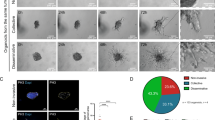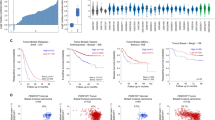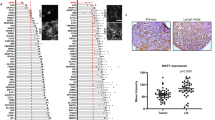Abstract
Intratumoral heterogeneity (ITH) represents an obstacle for cancer diagnosis and treatment, but little is known about its functional role in cancer progression. The A Desintegrin And Metalloproteinase 23 (ADAM23) gene is epigenetically silenced in different types of tumors, and silencing is often associated with advanced disease and metastasis. Here, we show that invasive breast tumors exhibit significant ADAM23-ITH and that this heterogeneity is critical for tumor growth and metastasis. We demonstrate that while loss of ADAM23 expression enhances invasion, it causes a severe proliferative deficiency and is not itself sufficient to trigger metastasis. Rather, we observed that, in ADAM23-heterotypic environments, ADAM23-negative cells promote tumor growth and metastasis by enhancing the proliferation and invasion of adjacent A23-positive cells through the production of LGI4 (Leucine-rich Glioma Inactivated 4) and nitric oxide (NO). Ablation of LGI4 and NO in A23-negative cells significantly attenuates A23-positive cell proliferation and invasion. Our work denotes a driving role of ADAM23-ITH during disease progression, shifting the malignant phenotype from the cellular to the tissue level. Our findings also provide insights for therapeutic intervention, enforcing the need to ascertain ITH to improve cancer diagnosis and therapy.
This is a preview of subscription content, access via your institution
Access options
Subscribe to this journal
Receive 50 print issues and online access
$259.00 per year
only $5.18 per issue
Buy this article
- Purchase on Springer Link
- Instant access to full article PDF
Prices may be subject to local taxes which are calculated during checkout





Similar content being viewed by others
References
Cairns J . Mutation selection and the natural history of cancer. Nature 1975; 15: 197–200.
Fidler IJ, Kripke ML . Metastasis results from preexisting variant cells within a malignant tumor. Science 1977; 197: 893–895.
Marusyk A, Almendro V, Polyak K . Intratumor heterogeneity: a looking glass for cancer? Nat Rev Cancer 2012; 19: 323–334.
Merlo LM, Pepper JW, Reid BJ, Maley CC . Cancer as an evolutionary and ecological process. Nat Rev Cancer 2006; 6: 924–935.
Michor F, Polyak K . The origins and implications of intratumor heterogeneity. Cancer Prev Res 2010; 3: 1361–1364.
Nowell PC . The conal evolution of tumor cell populations. Science 1976; 194: 23–28.
Swanton C . Intratumor heterogeneity: evolution through space and time. Cancer Res 2012; 72: 4875–4882.
Suzuki N, Withers HR, Koehler MW . Heterogeneity and variability of artificial lung colony-forming ability among clones from mouse fibrosarcoma. Cancer Res 1978; 38: 3349–3351.
Anderson K, Lutz C, van Delft FW, Bateman CM, Guo Y, Colman SM et al. Genetic variegation of clonal architecture and propagating cells in leukaemia. Nature 2011; 469: 356–361.
Clark J, Attard G, Jhavar S, Flohr P, Reid A, De-Bono J et al. Complex patterns of ETS gene alteration arise during cancer development in the human prostate ETS gene rearrangements in prostate tissues. Oncogene 2008; 27: 1993–2003.
Cottu PH, Asselah J, Lae M, Pierga JY, Diéras V, Mignot L et al. Intratumoral heterogeneity of HER2/neu expression and its consequences for the management of advanced breast cancer. Ann Oncol 2008; 19: 595–597.
Gerlinger M, Rowan AJ, Horswell S, Larkin J, Endesfelder D, Gronroos E et al. Intratumor heterogeneity and branched evolution revealed by multiregion sequencing. New Engl J Med 2012; 366: 883–892.
Maley CC, Galipeau PC, Finley JC, Wongsurawat VJ, Li X, Sanchez CA et al. Genetic clonal diversity predicts progression to esophageal adenocarcinoma. Nat Genet 2006; 38: 468–473.
Navin N, Kendall J, Troge J, Andrews P, Rodgers L, McIndoo J et al. Tumor evolution inferred by single-cell sequencing. Nature 2011; 7: 90–94.
Notta F, Mullighan CG, Wang JC, Poeppl A, Doulatov S, Phillips LA et al. Evolution of human BCR–ABL1 lymphoblastic leukemia initiating cells. Nature 2011; 469: 362–367.
Takahashi T, Habuchi T, Kakehi Y, Mitsumori K, Akao T, Terachi T et al. Clonal and chronological genetic analysis of multifocal cancers of the bladder and upper urinary tract. Cancer Res 1998; 15: 5835–5841.
Teixeira MR, Pandis N, Bardi G, Andersen JA, Heim S . Karyotypic comparisons of multiple tumorous and macroscopically normal surrounding tissue samples from patients with breast cancer. Cancer Res 1996; 56: 855–859.
Yachida S, Jones S, Bozic I, Antal T, Leary R, Fu B et al. Distant metastasis occurs late during the genetic evolution of pancreatic cancer. Nature 2010; 467: 1114–1119.
Yancovitz M, Litterman A, Yoon J, Ng E, Shapiro RL, Berman RS et al. Intra- and inter-tumor heterogeneity of BRAFV600E mutations in primary and metastatic melanoma. PLoS One 2012; 7: e29336.
Almendro V, Marusyk A, Polyak K . Cellular heterogeneity and molecular evolution in cancer. Annu Rev Pathol 2013; 24: 277–302.
Inda MM, Bonavia R, Mukasa A, Narita Y, Sah DW, Vandenberg S et al. Tumor heterogeneity is an active process maintained by a mutant EGFR-induced cytokine circuit in glioblastoma. Genes Dev 2010; 24: 1731–1745.
Yap TA, Gerlinger M, Futreal PA, Pusztai L, Swanton C . Intratumor heterogeneity: seeing the wood for the trees. Sci Transl Med 2012; 28: 127ps10.
Axelrod R, Axelrod DE, Pienta KJ . Evolution of cooperation among tumor cells. Proc Natl Acad Sci USA 2006; 103: 13474–13479.
Blobel CP . ADAMs: key components in EGFR signalling and development. Nat Rev Mol Cell Biol 2005; 6: 32–34.
Costa FF, Colin C, Shinjo SM, Zanata SM, Marie SK, Sogayar MC et al. ADAM23 methylation and expression analysis in brain tumors. Neurosci Lett 2005; 380: 260–264.
Costa FF, Verbisck NV, Salim AC, Ierardi DF, Pires LC, Sasahara RM et al. Epigenetic silencing of the adhesion molecule ADAM23 is highly frequent in breast tumors. Oncogene 2004; 23: 1481–1488.
Verbisck NV, Costa ET, Costa FF, Cavalher FP, Costa MD, Muras A et al. ADAM23 negatively modulates alpha(v)beta(3) integrin activation during metastasis. Cancer Res 2009; 69: 5546–5552.
Hagihara A, Miyamoto K, Furuta J, Hiraoka N, Wakazono K, Seki S et al. Identification of 27 5′-CpG islands aberrantly methylated and 13 genes silenced in human pancreatic cancers. Oncogene 2004; 23: 8705–8710.
Takada H, Imoto I, Tsuda H, Nakanishi Y, Ichikura T, Mochizuki H et al. ADAM23, a possible tumor suppressor gene, is frequently silenced in gastric cancers by homozygous deletion or aberrant promoter hypermethylation. Oncogene 2005; 24: 8051–8060.
Calmon MF, Colombo J, Carvalho F, Souza FP, Filho JF, Fukuyama EE, et al. Methylation profile of genes CDKN2A (p14 and p16), DAPK1, CDH1, and ADAM23 in head and neck cancer. Cancer Genet Cytogenet 2007; 173: 31–37.
Choi JS, Kim KH, Jeon YK, Kim SH, Jang SG, Ku JL et al. Promoter hypermethylation of the ADAM23 gene in colorectal cancer cell lines and cancer tissues. Int J Cancer 2009; 124: 1258–1262.
Hu C, Lv H, Pan G, Cao H, Deng Z, Hu C et al. The expression of ADAM23 and its correlation with promoter methylation in non-small-cell lung carcinoma. Int J Exp Pathol 2011; 92: 333–339.
Yamada KM, Cukierman E . Modeling tissue morphogenesis and cancer in 3D. Cell 2007; 130: 601–610.
Senechal KR, Thaller C, Noebels JL . ADPEAF mutations reduce levels of secreted LGI1, a putative tumor suppressor protein linked to epilepsy. Hum Mol Genet 2005; 14: 1613–1620.
Nishino J, Saunders TL, Sagane K, Morrison SJ . LGI4 promotes the proliferation and differentiation of glial lineage cells throughout the developingperipheral nervous system. J Neurosci 2010; 45: 15228–15240.
Sagane K, Ishihama Y, Sugimoto H . LGI1 and LGI4 bind to ADAM22, ADAM23 and ADAM11. Int J Biol Sci 2008; 4: 387–396.
Ozkaynak E, Abello G, Jaegle M, van Berge L, Hamer D, Kegel L et al. Adam22 is a major neuronal receptor for LGI4-mediated Schwann cell signaling. J Neurosci 2010; 30: 3857–38564.
Garthwaite J, Boulton CL . Nitric oxide signaling in the central nervous system. Annu Rev Physiol 1995; 57: 683–706.
Gauthier N, Lohm S, Touzery C, Chantôme A, Perette B, Reveneau S et al. Tumor-derived and host-derived nitric oxide differentially regulate breast carcinoma metastasis to the lungs. Carcinogenesis 2004; 25: 1559–1565.
Jadeski LC, Hum KO, Chakraborty C, Lala PK . Nitric oxide promotes murine mammary tumor growth and metastasis by stimulating tumor cell migration, invasiveness and angiogenesis. Int J Cancer 2000; 86: 30–39.
Orucevic A, Bechberger J, Green AM, Shapiro RA, Billiar TR, Lala PK . Nitric-oxide production by murine mammary adenocarcinoma cells promotes tumor-cell invasiveness. Int J Cancer 1999; 81: 889–896.
Bermingham JR, Shearin H, Pennington J, O'Moore J, Jaegle M, Driegen S et al. The claw paw mutation reveals a role for LGI4 in peripheral nerve development. Nat Neurosci 2006; 9: 76–84.
Kim HA, Park WJ, Jeong HS, Lee HE, Lee SH, Kwon NS et al. Leucine-rich glioma inactivated 3 regulates adipogenesis through ADAM23. Biochim Biophys Acta 2012; 6: 914–922.
Lampson BL, Kendall SD, Ancrile BB, Morrison MM, Shealy MJ, Barrientos KS et al. Targeting eNOS in pancreatic cancer. Cancer Res 2012; 72: 4472–4482.
Sens-Abuázar C, Napolitano E, Ferreira E, Osório CA, Krepischi AC, Ricca TI et al. Down-regulation of ANAPC13 and CLTCL1: early events in the progression of preinvasive ductal carcinoma of the breast. Transl Oncol 2012; 5: 113–123.
Pfaffl MW . A new mathematical model for relative quantification in real-time RT–PCR. Nucleic Acids Res 2001; 29: e45.
Cal S, Freije JMP, López JM, Takada Y, López-Otín C . ADAM 23/MDC3, a human disintegrin that promotes cell adhesion via interaction with the αvβ3 integrin through an RGD-independent mechanism. Mol Biol Cell 2000; 11: 1457–1469.
Price JE, Polyzos A, Zhang RD, Daniels LM . Tumorigenicity and metastasis of human breast carcinoma cell lines in nude mice. Cancer Res 1990; 50: 717–721.
Kojima H, Nakatsubo N, Kikuchi K, Kawahara S, Kirino Y, Nagoshi H et al. Detection and imaging of nitric oxide with novel fluorescent indicators: diaminofluoresceins. Anal Chem 1998; 70: 2446–2453.
Acknowledgements
We are grateful to Dr Andrew Simpson and Dr Raphael Parmigiani for critical reading of this manuscript and to Dr Rodrigo Perez, Dr Alicia Kowaltowski, Dr Beatriz Geronymo, Dr Camila Machado, Dr Vilma Martins, Dr Tiago dos Santos and Dr Anibal Vercesi for scientific discussions and technical assistance. This work was supported by grants from FAPESP (06/60219-2, 07/51194-9, 07/52920-5, 11/50541-2) and LICR.
Author information
Authors and Affiliations
Corresponding author
Ethics declarations
Competing interests
The authors declare no conflict of interest.
Additional information
Supplementary Information accompanies this paper on the Oncogene website
Supplementary information
Rights and permissions
About this article
Cite this article
Costa, E., Barnabé, G., Li, M. et al. Intratumoral heterogeneity of ADAM23 promotes tumor growth and metastasis through LGI4 and nitric oxide signals. Oncogene 34, 1270–1279 (2015). https://doi.org/10.1038/onc.2014.70
Received:
Revised:
Accepted:
Published:
Issue Date:
DOI: https://doi.org/10.1038/onc.2014.70



